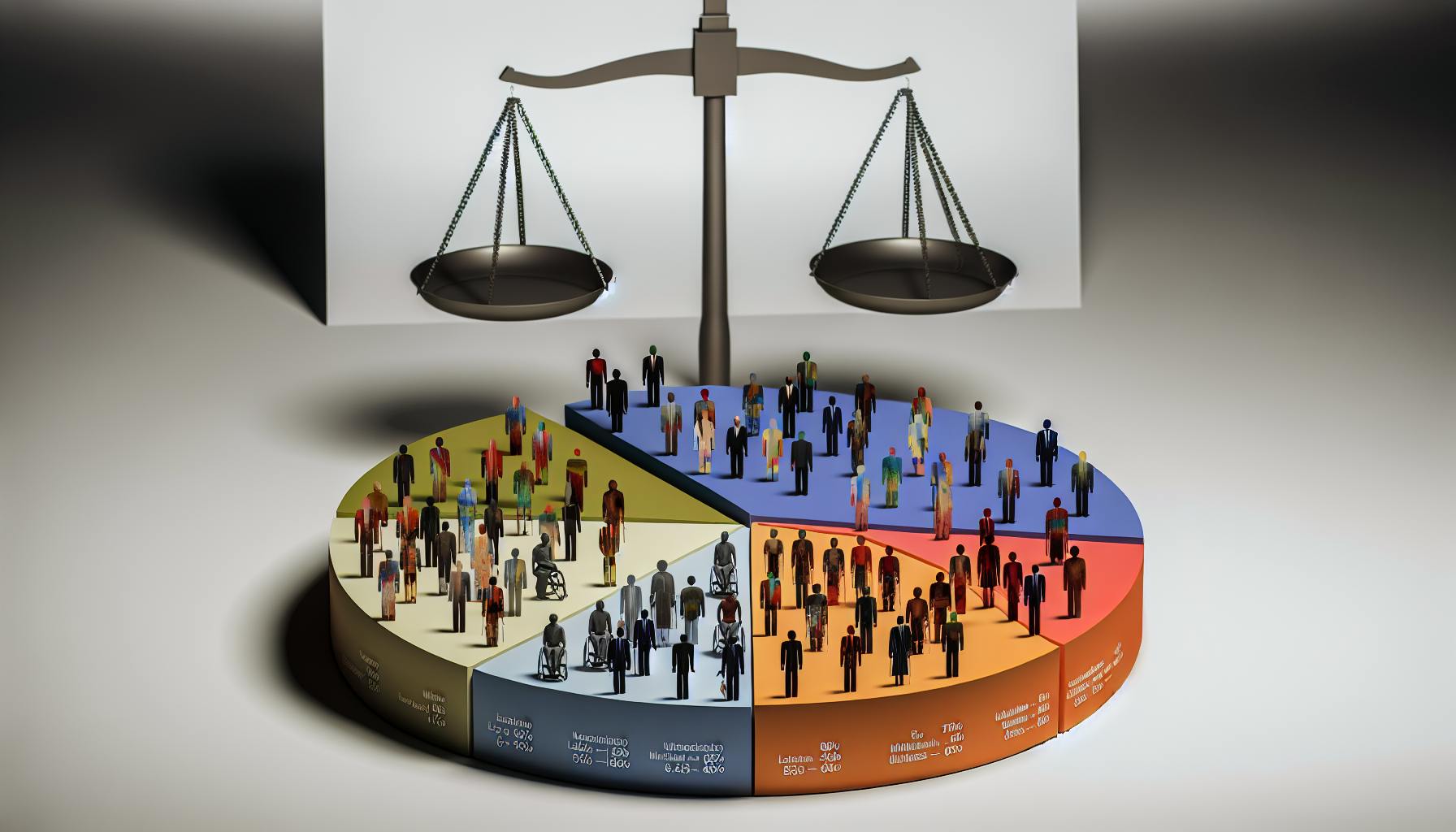Most organizations understand the ethical and business case for workplace diversity, equity, and inclusion.
This article explores the essential policies and best practices to create a truly inclusive culture where all employees feel valued, empowered, and able to contribute their unique talents.
You'll learn the legal frameworks, training programs, accountability measures, and other strategies to make diversity, equity, and inclusion integral to your organization's DNA for innovation and impact.
Introduction to Diversity, Equity, and Inclusion That Matter
Diversity, Equity, and Inclusion Definitions
Diversity refers to the presence of differences within a given setting. In the workplace, this includes differences in gender, race, ethnicity, age, physical abilities, religion, sexual orientation, socioeconomic status, and more.
Equity refers to fairness and justice in access to opportunities and resources. It involves identifying and eliminating barriers that prevent full participation and contributions from all groups.
Inclusion refers to involving, respecting, and valuing all individuals. It focuses on creating a sense of belonging by leveraging diversity and ensuring equitable policies and practices.
The Business Case for DEI: Delivering through Diversity
Research shows that diverse and inclusive workplaces lead to better business performance. Companies with greater diversity are more innovative, more profitable, have higher revenue, better decision making, stronger governance, and outperform the market average. Employees also report higher job satisfaction when working in diverse and inclusive environments.
The global workforce is increasingly diverse. Organizations that reflect the diversity of their stakeholders and marketplace can better meet customer needs. They also have an advantage attracting top talent.
Current Landscape and Challenges in Workplace Diversity
While progress has been made, diversity gaps persist, especially at leadership levels. For example, only 5% of Fortune 500 CEOs are women. Racial diversity also declines dramatically moving up the corporate ladder.
Many employees from underrepresented groups face discrimination, harassment, pay gaps, lack of advancement opportunities, and feelings of exclusion. Transgender employees in particular report high rates of mistreatment.
Organizations seeking true diversity, equity and inclusion face challenges like unconscious bias in hiring and promotions, lack of diversity in leadership pipelines and succession plans, pay inequities, hostile company cultures, and backlash against diversity efforts.
What is meant by diversity, equity, and inclusion?
Diversity, equity, and inclusion (DEI) refers to policies, programs, and initiatives that promote representation, participation, and belonging for people of all backgrounds in the workplace. This encompasses differences in age, race, ethnicity, ability, disability, gender identity, religion, culture, sexual orientation, socioeconomic status, and more.
DEI efforts aim to create a welcoming environment where all employees feel valued, respected, supported, and able to fully contribute. The goal is to foster a culture of inclusiveness that empowers people to bring their authentic selves to work.
Some key aspects of DEI include:
- Diversity: Ensuring there is representation of diverse communities, perspectives, and experiences reflected in an organization's workforce composition and leadership. This means taking proactive steps around recruitment, hiring, retention, and advancement.
- Equity: Recognizing systemic barriers that have historically excluded or disadvantaged certain groups. Equity initiatives seek to correct imbalances of opportunity through targeted interventions, resources, accommodations and by removing obstacles.
- Inclusion: Making people of all backgrounds feel welcomed, safe, supported, respected and valued as integral members of the organization. This is cultivated through policies, behaviors, norms, and an environment where people feel they belong.
Many leading companies now see DEI as a strategic priority that is mission critical. Research shows that diverse and inclusive workplaces experience higher innovation, engagement, productivity, and profitability over the long run.
What is DEI and give an example?
Diversity, equity, and inclusion (DEI) refer to policies, programs, and initiatives that promote:
- Diversity: Representation of different backgrounds, identities, abilities, perspectives, and experiences. This includes diversity in gender, race, ethnicity, age, religion, language, sexual orientation, disability status, veteran status, education, etc.
- Equity: Fair treatment, access, opportunities, and advancement for all. Identifying and eliminating barriers that prevent full participation.
- Inclusion: Fostering a culture where all individuals feel welcomed, respected, valued, heard, and able to reach their full potential.
An example DEI initiative is implementing inclusive hiring practices, such as:
- Having a diverse hiring committee review applications blindly without seeing demographic info
- Ensuring job postings use inclusive language and don't deter minority applicants
- Partnering with organizations that help recruit minority candidates
- Providing unconscious bias training for hiring managers
- Setting diversity hiring goals and tracking progress over time
The goal is to remove biases from the hiring process and increase representation of marginalized groups. This creates a more diverse workforce and inclusive environment where all employees feel valued and able to excel.
What is a statement of diversity, inclusion and equity?
A statement of diversity, inclusion, and equity outlines an organization's commitment to fostering a diverse and inclusive workplace where all employees feel valued, respected, and supported.
These statements communicate an organization's core values and principles related to diversity, equity, and inclusion (DEI). They demonstrate to both current and prospective employees that the organization prioritizes DEI as part of its culture.
Effective DEI statements should:
- Clearly define what diversity, equity, and inclusion mean to the organization
- Highlight specific goals, actions, and accountability measures
- Emphasize the organization's commitment to eliminating discrimination
- Explain why DEI matters to the organization's mission and values
- Use inclusive language that resonates with diverse audiences
Crafting an authentic, thoughtful DEI statement is an opportunity for organizations to reflect on their culture and communicate their dedication to meaningful progress in this area. It serves as a public pledge that sets expectations internally and externally about the practices, policies, and values that shape the lived experiences of employees.
What are the principles of diversity, inclusion and equity?
The key principles that support diversity, inclusion, and equity in the workplace are:
- Treating all people with respect and dignity - This means not making assumptions or judgments about individuals based on their identities. It involves being open-minded, listening actively, and fostering psychological safety.
- Valuing differences and diversity - Seeking to understand diverse perspectives enriches organizations. Diversity drives innovation. Varied backgrounds, abilities, and experiences should be appreciated.
- Eliminating unfair barriers - Removing biases in systems and processes ensures equal access to opportunities. This means regularly evaluating policies through an equity lens.
- Making merit-based judgments - Basing decisions on equitable criteria, rather than biases or stereotypes. Performance and contributions should be assessed fairly.
These principles aim to create safe, inclusive environments where all employees can thrive based on their talents and efforts. They are essential for organizations that want to attract and retain top talent from all backgrounds.
Implementing these values requires concerted efforts at multiple levels. From ensuring leadership commitment to conducting bias training, organizations must embed these ideals throughout their culture. Consistent messaging, policies, and practices are key to meaningful progress.
With inclusive mindsets and equitable systems, companies can gain diversity's many benefits - greater innovation, better decision making, and higher employee engagement and retention. Ultimately, diversity, inclusion and equity are integral to an organization's success.
sbb-itb-34a8e9f
Legal Frameworks and Foundational Policies for DEI
Establishing a strong legal and policy foundation is essential for organizations seeking to foster diversity, equity, and inclusion (DEI) in the workplace. This involves implementing anti-discrimination protections, regular pay equity analyses, workforce demographic tracking, DEI training programs, and accountability measures.
Anti-Discrimination and Equal Opportunity Laws
Organizations should have clear anti-discrimination and equal employment opportunity policies aligned with federal and state laws. These policies should cover hiring practices, compensation, promotions, terminations, and general workplace treatment, ensuring no one faces discrimination due to protected characteristics like race, gender, age, or disability. Leadership should consistently communicate these policies and the consequences for violations.
Conducting Pay Equity Analyses to Promote Justice
Conducting regular pay equity analyses by gender, race, and other factors is key to promoting fair compensation across the organization. This involves statistically assessing if pay gaps exist between groups and proactively making adjustments to ensure all employees receive equitable pay for equivalent work.
Tracking Workforce Demographics for Racial and Gender Diversity
Tracking workforce demographics enables organizations to benchmark diversity, set representation goals, and measure progress over time. Metrics may include percentages of underrepresented groups in leadership, recruitment, retention, and promotion rates. This data guides strategic initiatives to close gaps.
Implementing Diversity, Equity and Inclusion Training
Implementing regular DEI education through seminars, workshops, and online courses builds cultural competence and awareness around bias and systemic inequities. Tailored training should be provided to all employees and be integrated into onboarding processes. Leadership support and participation in training conveys its importance.
Reporting and Accountability Measures in DEI
Transparent reporting and accountability systems reinforce commitment to DEI initiatives. Leaders responsible for DEI strategy should provide regular progress reports on representation goals and training efficacy. Tying DEI metrics to performance assessments also motivates accountability. An independent audit of policies and practices is prudent.
Creating an Inclusive Culture in the Workplace
An inclusive culture welcomes diversity and ensures all employees feel valued and able to contribute their full potential. Leadership commitment, employee resource groups, mentoring programs, accommodating policies, and inclusive spaces are key elements for nurturing this culture.
Leadership Commitment to Gender, Ethnic, and Age Diversity
- Executives and managers should clearly communicate support for diversity initiatives through words and actions. This gives credibility to DEI efforts.
- Leaders should set representation goals, e.g. aiming for 40% female executives by 2025. Tracking and reporting progress builds accountability.
- Training programs should educate leadership on mitigating subtle biases in hiring, promotions, assignments etc.
Empowering Employee Resource Groups and Affinity Networks
- Facilitate communities for women, minorities, LGBTQ+ individuals, working parents etc. to share experiences.
- Groups should have executive sponsors to liaise needs with leadership. Budgets support professional development and community building events.
- Groups provide feedback on policies and programs from their perspective. Their voices build inclusion.
Mentorship Programs to Empower Women and Minorities
- Match junior women and minorities with more senior mentors for guidance on navigating their career growth.
- Mentors share insider knowledge on unwritten rules of advancement, provide connections and visibility to opportunities.
- Such programs lead to higher retention and promotion rates for marginalized groups.
Flexible Policies for Physical Ability and Neurodiversity
- Offer options like remote work, flexible scheduling, additional leave etc. to accommodate different needs.
- Ensure work sites and technology have accessibility features for physical disabilities or processing differences.
- Disclose accommodations openly to encourage adoption without stigma or penalty.
Inclusive Physical Spaces and Branding
- Images, symbols and office design choices should represent diverse communities rather than a homogenous majority.
- Gender neutral bathrooms, nursing rooms, prayer rooms etc. make facilities more welcoming.
- Events and celebrations should reflect a range of cultural backgrounds, avoiding assumptions.
In summary, diversity without inclusion breeds tokenism. An inclusive culture empowers all talent to thrive by fostering trust, belonging and growth opportunities for marginalized groups.
DEI Strategies for Impactful Recruiting and Hiring
This section examines how to integrate DEI into talent acquisition processes in order to build a diverse workforce pipeline.
Mitigating Bias in Job Descriptions for Inclusivity
Crafting inclusive, bias-free job postings is key to attracting diverse candidates. Here are some best practices:
- Use gender-neutral language and avoid terms that imply a preference for a particular demographic group. For example, replace "rockstar" with "stellar performer".
- Emphasize required skills and duties rather than subjective traits like "culture fit". Focus on qualifications.
- Ensure qualification requirements are inclusive and do not unconsciously screen out certain groups. Consider which requirements are truly necessary.
- Have multiple people review job postings to identify potentially exclusionary language.
- Use tools like Textio to analyze job posts for bias before publishing.
Strategies for Sourcing Diverse Candidate Pools
Expanding recruiting efforts beyond the typical channels is crucial for sourcing diverse candidates. Consider:
- Posting roles on diversity-focused job boards like Jopwell and HireTechLadies.
- Building partnerships with professional organizations supporting underrepresented groups like the National Black MBA Association.
- Sponsoring and recruiting at conferences and events catering to minority communities.
- Leveraging employee resource groups at your company to promote openings through their networks.
Objective Screening and Evaluation to Promote Fairness
Mitigating bias when screening resumes and evaluating candidates is key for diversity efforts. Tactics include:
- Using structured interviews with standardized questions asked of all candidates.
- Blind screening by removing names and demographic info from resumes during initial reviews.
- Establishing clear, consistent evaluation criteria applied equitably across all candidates.
- Ensuring diverse panels participate in assessment and selection decisions.
Conducting Inclusive Interviews
Interviews should give all candidates, regardless of background, an equal opportunity to demonstrate qualifications. Consider:
- Providing interview questions in advance for candidates to prepare if desired.
- Adjusting interviews to reasonably accommodate disabilities or special needs.
- Using panel or committee interviews to reduce effects of individual interviewer bias.
- Standardizing evaluation procedures using structured rubrics and consensus-based decisions.
Equitable Selection and Hiring Practices
Formalizing equitable final selection processes is vital for making fair, bias-free hiring decisions:
- Institute structured decision-making protocols outlining factors to consider for all roles.
- Have hiring managers document evidence-based rationales supporting their choices.
- Conduct periodic statistical analyses of hiring decisions to identify any demographic disparities.
- Compare selected candidates to the applicant pool using diversity dashboards to monitor impacts of programs.
Diversity, Equity and Inclusion in the Workplace Examples
This section highlights real-world examples of successful DEI policies and initiatives at leading companies.
Case Study: Increasing Financial Inclusion at Company A
Company A, a major financial services firm, has made significant strides in advancing inclusion through several key programs aimed at underrepresented groups. By implementing mentorship initiatives, leadership development courses, and networking groups for Black and Hispanic employees, Company A has increased the representation of these groups in mid-level and senior leadership roles by 15% and 24% respectively over the past three years.
Additionally, their financial literacy outreach initiatives targeted at Hispanic and Black communities have helped over 5,000 individuals open their first savings/checking accounts. Company A has set a goal by 2025 to help over 50,000 underbanked individuals gain access to essential financial services.
Case Study: Empowering Black Representation in Film and TV at Company B
Company B, a leader in the media entertainment industry, has committed $100 million over five years to fund and acquire content created by Black artists, production companies, and financial institutions. So far in year two of this initiative, Company B has funded 12 films and TV series led by Black creators that have generated over $200 million in global revenue.
Internally, Company B has also increased Black representation in creative leadership roles by 32% through formalized programs that identify, mentor, and promote high-potential Black candidates. The company aims to achieve proportional representation of Black employees at all levels by 2025.
Case Study: Asian Americans in Senior Leadership Roles at Company C
Company C, a pioneering technology company, has successfully increased Asian American representation in VP and SVP level roles from just 8% to 19% over the past four years. This remarkable progress is attributed to their data-driven approach of setting representation targets, implementing diverse candidate slates, mitigating bias in performance reviews, and offering customized leadership development programs.
As a result of these efforts, employee sentiment surveys show Asian American employees now rank Company C 40% higher on perceptions of inclusion and belonging compared to peer organizations. By continuing to scale initiatives that foster equity, Company C aims to elevate underrepresented talent into 30% of senior leadership roles by 2027.
Conclusion: Integrating Diversity, Equity, and Inclusion into Corporate DNA
Recap: The Value of Diverse Voices and Why Diversity Matters
Diversity, equity, and inclusion are essential elements of a fair, just, and productive workplace. As highlighted throughout this article, diverse teams outperform homogeneous ones, and companies reap significant benefits from embracing diversity. By giving equitable opportunities and resources to all employees, regardless of gender, race, age, or other attributes, organizations tap into a wealth of perspectives and talents. An inclusive environment where all team members feel valued, respected, and able to contribute their unique strengths fosters innovation, better decision making, and stronger business outcomes.
Essential Elements for Effective DEI Programs
To develop effective DEI initiatives, companies must:
- Secure buy-in and modeling from leadership
- Conduct regular bias and equity audits
- Provide ongoing training and education
- Implement equitable, inclusive policies and practices
- Set representation goals and track progress
- Solicit input from marginalized groups
- Foster open dialogues on tough issues
Following these best practices paves the way for real culture change and allows DEI to permeate an organization.
Next Steps: Developing a Data-Driven DEI Strategy
With a solid fact base established through audits and assessments, companies can determine priority DEI focus areas and metrics to track progress. HR leaders should develop targeted strategies and initiatives aimed at moving the needle on representation, equity, inclusion and belonging. AI tools like HRbrain's Culture Assessment and DE&I Bias Analysis generate data-backed insights to inform strategic decisions and measure impact over time. This data-driven approach to DEI supports real diversity wins and culture change.


